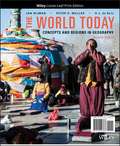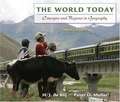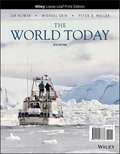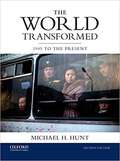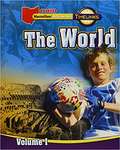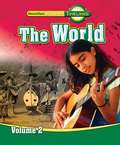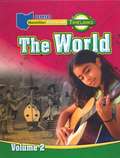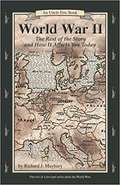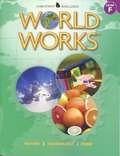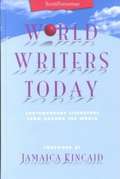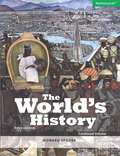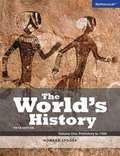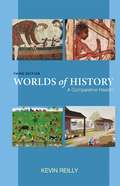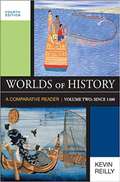- Table View
- List View
World Studies - Western Hemisphere: Reading and Vocabulary Study Guide
by Prentice Hall EditorsWorld Studies - Western Hemisphere: Reading And Vocabulary Study Guide
World Tapestries: An Anthology of Global Literature
by Globe FearonThis collection of unadapted classic and contemporary literature features the work of authors from various world cultures.
The World Today: Concepts And Regions In Geography
by Peter O. Muller Jan Nijman Harm J. de BlijThe World Today, Binder Ready Version, 7th Edition is the number one bestselling brief World Regional Geography textbook. The seventh edition continues to bring readers geographic perspectives on a fast-changing world through the regional view. Restructured chapters provide a macro review of important physical, cultural, and political characteristics, drawing upon up-to-date significant world events and crises. The cartographically superior maps have been updated for the seventh edition to offer an accurate and vast picture of the world--multi-layer, interactive, GIA maps have been added to WileyPLUS Learning Space. To complement the extensive map program, the majority of the photos have been taken by our authors during their field research, allowing the student to experience an authentic geographical viewpoint of our world.
The World Today: Concepts and Regions in Geography
by Peter O. Muller Eugene Joseph Palka H. J. de BlijTextbook on the geography of the world toward the close of the first decade of the twenty-first century as well as a guide to geographic ideas and perspectives, past and present.
The World Today: Concepts and Regions in Geography
by Jan Nijman Peter O. Muller Michael ShinIn the 8th edition of this market-leading title, The World Today continues to break new ground in the interpretation and teaching of world regional geography. The text explains the contemporary world’s geographic realms in terms of their natural environments and human dimensions in a clear and concise fashion. The authors look at the ways people have organized their living space, adapted to changing social as well as environmental circumstances, and continue to confront forces largely beyond their control ranging from globalization to climate change. <p> This book offers an approach to Geography that meshes theoretical concepts with regional realities. The evolving regional content of the chapters in the 8th edition of The World Today reflects the dynamic nature of the world’s geography; the changing and growing number of concepts mirror the progress of the discipline; and the ongoing introduction of new digital features reflects the instructional possibilities of new technologies.
The World Transformed: 1945 To The Present
by Michael H. HuntThrough its lively and accessible narrative, The World Transformed: 1945 to Present provides students with an account of the political, socio-economic, and cultural developments that have shaped global events since 1945. The book's focus on three central and profoundly interconnected stories--the unfolding of the Cold War, the growth of the international economy, and the developing world's quest for political and economic independence--offers students a framework for understanding the past and making sense of the present. Attentive to overarching themes, individual historical figures, and diverse nations--and now substantially revised with a new Part 4 that examines world events since 1990--The World Transformed, Second Edition, is ideal for courses on post-1945 world history, international relations, or global topics.
The World Transformed, 1945 To The Present: A Documentary Reader
by Michael H. HuntDesigned to accompany The World Transformed, 1945 to the Present, this comprehensive reader offers a wealth of primary sources on the pivotal events that shaped the post-1945 world. Complemented by an editorial apparatus that supports and enhances students’ reading of the documents and helps them to understand the interlocking nature of historical developments, this invaluable collection will appeal to anyone teaching courses on post-1945 world history, international relations, the cold war and globalization.
The World, Volume 1
by James A. Banks Kevin P. Colleary Linda GreenowMacmillian/McGraw-Hill TIMELINKS Grade 4 (or grade 5 or 6) builds geographic mastery with maps and skills, offers reading skills and strategies to reinforce Reading/Language Arts skills, and integrates Dinah Zike’s Foldables® to help students improve comprehension. • Two volumes per grade • Available as single copies or in grade level sets
The World, Volume 1 [Grade 6] (Ohio Timelinks)
by Linda Greenow James Banks Kevin CollearyNIMAC-sourced textbook <P><P>Macmillian/McGraw-Hill TIMELINKS builds geographic mastery with maps and skills, offers reading skills and strategies to reinforce Reading/Language Arts skills, and integrates Dinah Zike’s Foldables® to help students improve comprehension.
The World Volume 1 (Macmillan/McGraw-Hill TIMELINKS)
by McGraw-Hill Education Staff6th Grade Social Studies Textbook
The World, Volume 2
by James A. Banks Kevin P. Colleary Linda GreenowMacmillian/McGraw-Hill TIMELINKS Grade 4 (or grade 5 or 6) builds geographic mastery with maps and skills, offers reading skills and strategies to reinforce Reading/Language Arts skills, and integrates Dinah Zike’s Foldables® to help students improve comprehension. • Two volumes per grade • Available as single copies or in grade level sets
The World, Volume 2 [Grade 6]
by James A. Banks Kevin P. Colleary Linda GreenowNIMAC-sourced textbook
World War II: The Rest of the Story and How It Affects You Today, 1930 to September 11, 2001 (Uncle Eric Book #11)
by Richard J. Maybury Jane A. WilliamsMr. Maybury presents an idea-based explanation of the Second World War. He focuses on events in the Second World War and how our misunderstanding of this war led to America s subsequent wars, including the Korean and Vietnam Wars, the Iraq-Kuwait War, and the "war on terrorism" that began September 11, 2001. <P><P>To improve the student's learning experience, also purchase the student study guide for "World War II" titled "A Bluestocking Guide: World War II" also available through Amazon. <P><P>Can be used for courses in World History, U.S. History, International Relations, Economics, Business, Finance, and Government.
The World War II Years
by Cathleen Schurr Charles HipserIt's September 3, 1939, and England and France have just declared war on Germany. Aboard the Athenia, Cathleen is a victim of a Nazi submarine torpedo. How will she survive? Some of six-year-old Charles's treasures are bullets, grenades, and artillery shells. What was it like growing up in German-occupied France during World War II? Read these memoirs to find out.
World Weather Handbook, Reference Book
by Emily Gibson Ben Schleifer Chloë DelafieldNIMAC-sourced textbook
World Works, Level F: Nature, Technology, Food
by McGraw-HillExplore how things work through high-interest, engaging informational nonfiction!Improve reading comprehension of informational nonfiction, encourage student inquiry with high-interest topics, and prepare students for high-stakes assessments with the World WorksTM series from Jamestown Education. World WorksTM brings the world to life. Each four-color, consumable book of the 6-book series features 9 informational articles focused on how things work. Each unit within a book covers one of the following topics; Everyday Things, Law, Health, Food, Technology, or Nature. All categories are covered at each reading level. Each article answers the question, "How Does it Work?" Each informational article includes a graph, chart, or diagram, along with an after-reading critical-thinking questions on interpreting charts and graphs.
World Writers Today
by Addison WesleyThese collections of literature are perfect for additional reading.
The World's Biggest Classroom (Fountas & Pinnell Classroom, Guided Reading Grade 4)
by Alicia FenwickAn Unusual School Australia is a HUGE country. Many families live in remote areas, far apart from one another. So how do the children in these families go to school together? NIMAC-sourced textbook
The World's History
by Howard SpodekThe World’s History encourages readers to explore the history of the world and the significance of this unique study. The past is not simply a list of events, rather the records of historic interpretations of those events. Because interpretations differ from historian to historian, the study of history becomes a pool of various narrations told from different perspectives. The World’s History celebrates these differentiating values offering readers a rich, comprehensive, and challenging introduction to the study of world history and the methods and key interpretations of its historians. This title links chronology, themes, and geography in eight units, or parts of study. The parts move progressively along a timeline from emergence of early humans to the present day encouraging students to analyze historical events and develop a grasp of the chronology of human development. Readers will gain an appreciation of the national and cultural origins of all their diverse fellow citizens.
The World's History, Combined Volume (3rd edition)
by Howard SpodekThe professional historian and the student of an introductory course often seem to pass each other on different tracks. For the professional, nothing is more fascinating than history. For the student, particularly one in a compulsory course, the whole enterprise often seems a bore. This introductory text is designed to help the student understand and share the fascination of the historian. It will also remind professors of their original attraction to history, before they began the specialization that has almost certainly marked their later careers.
The World's History Volume One: Prehistory to 1500 Fifth Edition
by Howard SpodekThe World''s History encourages readers to explore the history of the world and the significance of this unique study. The past is not simply a list of events, rather the records of historic interpretations of those events. Because interpretations differ from historian to historian, the study of history becomes a pool of various narrations told from different perspectives. The World''s History celebrates these differentiating values offering readers a rich, comprehensive, and challenging introduction the the study of world history and the methods and key interpretations of its historians. The World''s History: Volume 1 covers Parts One through Five(chapters 1-13). The parts move progressively along a timeline from emergence of early humans to the present day encouraging students to analyze historical events and develop a grasp of the chronology of human development. Readers will gain an appreciation of the national and cultural origins of all their diverse fellow citizens.
The World's Messiest Food Fights (Fountas & Pinnell Classroom, Guided Reading Grade 2)
by Davia LukeNIMAC-sourced textbook
The World's Ocean: Science 6. 4 The World's Ocean
by National Geographic LearningNIMAC-sourced textbook
Worlds of History: A Comparative Reader
by Kevin ReillyWorlds of History offers a flexible comparative and thematic organization that accommodates a variety of teaching approaches and helps students to make cross-cultural comparisons. Thoughtfully compiled by a distinguished world historian and community college instructor, each chapter presents a wide array of primary and secondary sources arranged around a major theme -- such as universal religions, the environment and technology, or gender and family -- across two or more cultures.
Worlds of History Since 1400: A Comparative Reader
by Kevin ReillyCompiled by a widely respected world historian and community college teacher, Worlds of History fosters historical thinking through thematic comparisons of primary and secondary sources from around the world. Each chapter takes up a major theme — such as patriarchy, love and marriage, or globalization — as experienced by two or more cultures. "Thinking Historically" exercises build students’ capacity to analyze and interpret sources one skill at a time. This flexible framework accommodates a variety of approaches to teaching world history. The latest edition offers a broader range of sources with an even more global perspective.


